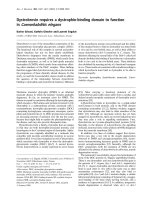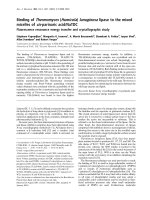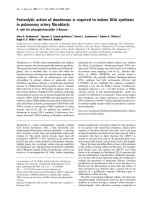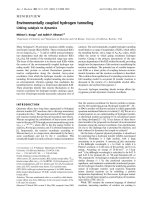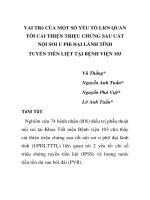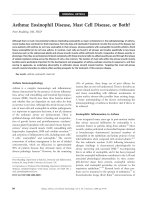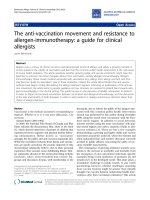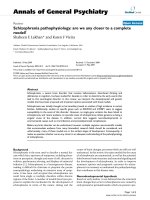Báo cáo Y học: Environmentally coupled hydrogen tunneling Linking catalysis to dynamics potx
Bạn đang xem bản rút gọn của tài liệu. Xem và tải ngay bản đầy đủ của tài liệu tại đây (243.38 KB, 9 trang )
MINIREVIEW
Environmentally coupled hydrogen tunneling
Linking catalysis to dynamics
Michael J. Knapp
1
and Judith P. Klinman
1,2
1
Department of Chemistry and
2
Department of Molecular and Cell Biology, University of California, Berkeley, USA
Many biological C-H activation reactions exhibit nonclas-
sical kinetic isotope effects (KIEs). These nonclassical KIEs
aretoolarge(k
H
/k
D
> 7) and/or exhibit unusual tempera-
ture dependence such that the Arrhenius prefactor KIEs
(A
H
/A
D
) fall outside of the semiclassical range near unity.
The focus of this minireview is to discuss such KIEs within
the context of the environmentally coupled hydrogen tun-
neling model. Full tunneling models of hydrogen transfer
assume that protein or solvent fluctuations generate a
reactive configuration along the classical, heavy-atom
coordinate, from which the hydrogen transfers via nuclear
tunneling. Environmentally coupled tunneling also invokes
an environmental vibration (gating) that modulates the
tunneling barrier, leading to a temperature-dependent KIE.
These properties directly link enzyme fluctuations to the
reaction coordinate for hydrogen transfer, making a quan-
tum view of hydrogen transfer necessarily a dynamic view of
catalysis. The environmentally coupled hydrogen tunneling
model leads to a range of magnitudes of KIEs, which reflect
the tunneling barrier, and a range of A
H
/A
D
values, which
reflect the extent to which gating modulates hydrogen
transfer. Gating is the primary determinant of the tem-
perature dependence of the KIE within this model, providing
insight into the importance of this motion in modulating the
reaction coordinate. The potential use of variable tempera-
ture KIEs as a direct probe of coupling between environ-
mental dynamics and the reaction coordinate is described.
The evolution from application of a tunneling correction to a
full tunneling model in enzymatic H transfer reactions is
discussed in the context of a thermophilic alcohol dehy-
drogenase and soybean lipoxygenase-1.
Keywords: hydrogen tunneling; kinetic isotope effects; lip-
oxygenase; protein dynamics; reaction coordinate.
INTRODUCTION
Quantum effects have long been appreciated in biological
electron transfer (ET) reactions, due to the large uncertainty
in position for the e
–
. The quantum nature of ET has required
new reaction models that go beyond transition-state theory.
Marcus recognized the contribution of heavy-atom coordi-
nates to the rate of ET through an environmental energy term
ðk
ET
/ e
ÀDG
z
=RT
Þ,whereDG
à
is the free energy barrier to
reaction, R is the gas constant, and T is absolute temperature
[1]. Importantly, the reaction coordinate according to
Marcus theory is, to a large extent, determined by the heavy
atom coordinates and not by the e
–
coordinate. This
remarkable insight is in stark contrast to typical assumptions
that the reaction coordinate for heavier particles is domin-
ated by the transferring group. Hydrogen transfer (H
+
,H
–
,
or H•) is another well known reaction in which appreciable
quantum-mechanical behavior is evident [2–10]. We are at a
crucial juncture in our understanding of hydrogen transfer,
as theoretical models accounting for its nonclassical nature
are being developed [11–15]. A key feature of these theor-
etical models is the proposed involvement of environmental
dynamics along the reaction coordinate. Can experimental-
ists rise to the challenge that is presented by theorists, and
find evidence for dynamics that couple to catalysis?
On the basis of general physical principles, it should not
be surprising that a hydrogen transfer exhibits nonclassical
behavior. Hydrogen is a light particle, with a large
uncertainty in its position. A measure of this uncertainty
is the deBroglie wavelength, k ¼ h/
ffiffiffiffiffiffiffiffiffi
2mE
p
,inwhichh is
Planck’s constant, m is the mass of the particle, and E is its
energy. Assuming an energy of 20 kJÆmol
)1
(% 5kcalÆ
mol
)1
) the deBroglie wavelength is calculated to be 0.63 A
˚
and 0.45 A
˚
for protium (H, or
1
H) and deuterium (D, or
2
H), respectively. As hydrogen is typically transferred over a
similar distance (< 1 A
˚
), this positional uncertainty is
significant, and implicates considerable nonclassical proper-
ties for hydrogen transfers. Despite the underlying quantum
nature of hydrogen transfer, such reactions frequently
mimic classical reactions (as by exhibiting a positive
temperature dependence); for this reason, hydrogen tunnel-
ing has typically been treated as a perturbation of transition-
state theory (TST) [16,17].
While TST remains the common language of chemical
reactions, increasing numbers of workers are coming to
Correspondence to J. P. Klinman, Department of Chemistry,
University of California, Berkeley, CA 94720, USA.
Fax: + 1 510 643 6232, Tel.: + 1 510 642 2668,
E-mail:
Abbreviations: ET, electron transfer; KIE, kinetic isotope effect;
D
k
cat
,
kinetic isotope effect on k
cat
; 13-(S)-HPOD, 13-(S)-hydroperoxy-9,11-
(Z,E)-octadecadienoic acid; LA, linoleic acid, 9,12-(Z,Z)-octadecadi-
enoic acid; TST, transition-state theory; TS, transition-state;
(WT)-SLO, (wild-type) soybean lipoxygenase-1; ht-ADH, thermo-
philic alcohol dehydrogenase; VT-KIE, variable temperature kinetic
isotope effect.
Definition: The term semiclassical refers to a model in which kinetic
isotope effects arise from differences in the zero-point energies of the
C-H and C-D stretches.
(Received 12 March 2002, revised 31 May 2002, accepted 6 June 2002)
Eur. J. Biochem. 269, 3113–3121 (2002) Ó FEBS 2002 doi:10.1046/j.1432-1033.2002.03022.x
appreciate [18] that such a model is over-simplified, as data
accumulate regarding the importance of quantum effects
[19,20] and dynamics [21–23] in enzyme catalysis. Bell
treated small deviations from classical behavior by correct-
ing the TST rates of hydrogen transfer for a finite tunneling
probability. In contrast to this are dissipative tunneling
models, in which hydrogen transfer is treated fully quan-
tum-mechanically, and interactions with the environment
can make the reaction ÔappearÕ classical. We will discuss the
progression in our thinking about hydrogen transfer, from
the tunnel corrections initially applied to hydride (H
–
)
transfers, to the full-tunneling models applicable to hydro-
gen atom (H•) transfers.
SEMICLASSICAL KINETIC ISOTOPE
EFFECTS AND TUNNELING
CORRECTIONS
Theories of enzyme catalysis have focussed on energetic
effects [24], such as the oft-cited concept of transition-state
stabilization [18]. Such explanations are aesthetically pleas-
ing, in that activated complex theory formulates the rate of a
reaction as ðk
TST
¼ Ae
ÀDG
z
=RT
Þ,inwhichA is a pre-
exponential term, and DG
à
is the energetic barrier to
reaction. It is natural to focus attention on the exponential
term, as a relatively small change in DG
à
leads to a large
change in k
TST
.ReducingDG
à
canbeachievedbyeither
stabilizing the transition-state, or by ground-state destabil-
ization; both lead to a similar reduction in DG
à
,and
significant alterations in k
TST
.
Kinetic isotope effects (KIEs) are mainstays for probing
chemical mechanisms, as they provide information on the
reaction coordinates. Primary (1°) KIEs are due to the
hydrogen that is transferred during a reaction. The semi-
classical KIE model, also called the bond-stretch model
(Fig. 1A) proposes that 1° KIEs arise from differences in
the zero-point energy upon isotopic substitution, and
formulates the rate of reaction as k
H
¼ A
H
exp
{–(DG
à
) ½hm
H
)/RT}, where m
H
is the vibrational fre-
quency of the transferred hydrogen and h is Planck’s
constant [17]. When comparing protium to deuterium, the
resultant variable temperature KIE is k
H
/k
D
¼ (A
H
/A
D
)
exp{(½hm
H
) ½hm
D
)/RT}. This neglects compensatory
motions in the transition state that could act to reduce the
size of the KIE [25]. The simple bond-stretch formalism
predicts an appreciable KIE at room temperature (% 7at
300 K), which vanishes at infinite temperature, as A
H
/
A
D
% 1 in this model. All further references to KIEs within
this review will be to 1° KIEs, unless noted otherwise.
Earlier theoretical treatments for hydrogen tunneling
were focussed on the Bell model [16], which was developed
to explain some of the peculiar behavior of organic reactions
in solution. Tunneling occurs just below the classical
transition-state in the Bell model, resulting in a relatively
small correction to the overall reaction rate and isotope
effect (Fig. 1B); depending on the extent of H or D
tunneling, different KIE patterns are predicted [26,27]. This
model is characterized by certain deviations of KIEs from
those calculated in the semiclassical model: inflated kinetic
isotope effects (H/D KIEs > 7), and an inverse isotope
effect on the Arrhenius prefactor ratios (A
H
/A
D
<1)as
measured by variable-temperature KIEs (VT-KIEs) [26].
Additionally, the exponent relating the three hydrogen
isotopes (H/T vs. D/T) has a characteristic value in the
semiclassical model [k
H
/k
T
¼ (k
D
/k
T
)
3.3
]; in mixed-label
KIE measurements, positive deviations from this value
(so-called Swain–Schaad deviations) have been presented as
evidence for tunneling within the Bell formalism [27].
In 1989, our group reported an elevated Swain–Schaad
exponent [k
H
/k
T
>(k
D
/k
T
)
3.3
] for the secondary (2°)KIE
in the alcohol oxidation catalyzed by yeast alcohol dehy-
drogenase, demonstrating hydride (H
–
) tunneling at room
temperature [2] (these a-2° KIEs are due to the nontrans-
ferred hydrogen of the alcohol). This research article was
rapidly followed by several other examples of hydrogen
tunneling, demonstrated by either Swain–Schaad deviations
or by Arrhenius prefactor ratios deviating from semiclas-
sical limits (A
H
/A
D
( 1). Swain–Schaad deviations for the
2° KIEs in mixed-label experiments were used to demon-
strate tunneling in horse liver alcohol dehydrogenase [28].
VT-KIEs were used to demonstrate tunneling through 1°
A
H
/A
D
ratios which deviated from unity in the proton (H
+
)
transfer catalyzed by bovine serum amine oxidase [5], and
the H• (or H
+
) transfer in monoamine oxidase-B [29]. The
observed KIEs were all consistent with a tunnel-correction
to a semiclassical hydrogen transfer.
Fig. 1. Hydrogen transfer reaction coordinate diagram, illustrating the
semiclassical (bond-stretch) model for kinetic isotope effects (A) and the
tunneling correction to the semiclassical model (B). (A) DG
à
is the free
energy barrier to hydrogen transfer, ½hm
H
and ½hm
D
denote the
zero-point energy for the C–H and C–D stretches, respectively. (B)
Hydrogen transfer reaction coordinate diagram illustrating the tun-
neling correction to the semiclassical model. H tunnels through the
barrier at a lower energy than does D.
3114 M. J. Knapp and J. P. Klinman (Eur. J. Biochem. 269) Ó FEBS 2002
BREAKING THE TUNNEL-CORRECTION:
THERMOPHILIC ALCOHOL
DEHYDROGENASE AND SOYBEAN
LIPOXYGENASE-1
Much of the early evidence for enzymatic hydrogen
tunneling could be explained within a tunnel-correction
model, as for the small-molecule reactions. This worked
very well for the moderate deviations of KIEs from
semiclassical predictions. Additional KIEs have been
reported by this lab [3, 6, 7], and by Scrutton and coworkers
[8,10], that are inconsistent with modest tunneling correc-
tions, and provide support for environmentally coupled
hydrogen tunneling. In both the thermophilic ADH from
Bacillus stearothermophilus (ht-ADH) and soybean lipoxyg-
enase (SLO), VT-KIEs revealed inflated Arrhenius prefac-
torratios(A
H
/A
D
) 1) and finite activation energies
(E
act
„ 0) that are incompatible with the Bell model
[6,7]. Furthermore, the A
H
/A
D
ratios were observed to
become inverse upon perturbing the system, with the
perturbant being temperature in ht-ADH, and site-specific
mutagenesis in SLO. As discussed below, a wide variation in
A
H
/A
D
can, in fact, be explained as arising from alterations
in the environmental dynamics that modulate hydrogen
tunneling.
The physiological temperature of B. stearothermophilus is
60–70 °C, sufficiently high that it was possible for Kohen
et al. to collect KIE data over a very wide temperature
range (5–65 °C) [7]. ht-ADH exhibited a Swain–Schaad
exponent on the 2° KIEs that exceeded 3.3 at all temper-
atures, indicating that the reaction catalyzed by ht-ADH
involves tunneling by this standard criterion. Furthermore,
the exponent increased as a function of temperature, from
%5(5°C) to %14 (65 °C), which suggested that tunneling
increased as a function of temperature, contrary to standard
views of temperature effects on tunneling. To further
complicate the picture, a convex Arrhenius plot was
obtained from the kinetic data, with a break point at
30 °C, below which k
cat
exhibited an increased activation
energy. Below 30 °C, the 1° KIEs exhibit an inverse A
H
/A
D
ratio (A
H
/A
D
¼ 1 · 10
)5
), whereas the KIEs above 30 °C
show an A
H
/A
D
ratio greater than unity (A
H
/A
D
¼ 2).
Sizeable activation energies, together with inverse Arrhenius
prefactor ratios, are predicted within the Bell model when
tunneling is significant; however, prefactor ratios greater
than unity are not.
Accommodating ht-ADH within any model requires that
one treat the enzyme as if it exists in two phases separated by
temperature, each with a different reaction coordinate and
extent of tunneling. It is not simple to predict why the
signatures of tunneling should be more pronounced at high
temperature. However, it was suggested that promotion of
hydrogen transfer via environmental oscillations could
provide an explanation of the data in ht-ADH [7].
Deuterium exchange experiments indicated greater flexibil-
ity of the ht-ADH at 60 °C than at reduced temperature
(25 °C), suggesting a correlation between global enzyme
flexibility and the extent of tunneling, and lending support
to the notion that environmental oscillations may modulate
hydrogen transfer [30]. In this view, the promoting
vibrations become Ôfrozen-outÕ below 30 °C, such that
hydrogen transfer is dominated by a more classical reaction
coordinate with a portion of H transfer occurring through-
thebarrier.Above30°C, available protein oscillations
contribute to the reaction coordinate, greatly increasing the
role of tunneling in the hydrogen transfer. Thus, the
experimental data for ht-ADH suggested a link between
enzyme dynamics and hydrogen transfer, even within the
context of a tunnel-correction model for hydride transfer.
Several notable examples of hydrogen atom transfer
exhibit KIEs so large that they cannot be explained within
any tunneling-correction model [3,31–33]. The H/D KIE for
the H• transfer of WT-SLO is greater than 80 at room
temperature, and the activation energy on H• transfer is
remarkably small (E
act
¼ 2.1 kcalÆmol
)1
) [9,34–36]. When
this result was reported, it signaled a new era in hydrogen
transfer chemistry, as it was so deviant as to make tunneling
corrections of dubious relevance. Explicit tunneling effects
are required to accommodate the kinetics of SLO, and may
be equally important in many other hydrogen atom transfer
reactions. Many H• transfer reactions are characterized by
very large inherent chemical barriers, such that movement
through, rather than over, the barrier may dominate the
reaction pathway.
SLO catalyzes the production of fatty acid hydroper-
oxides at 1,4-pentadienyl positions, and the product 13-(S)-
hydroperoxy-9,11-(Z,E)-octadecadienoic acid [13-(S)-
HPOD] is formed from the physiological substrate linoleic
acid (LA) (Scheme 1). This reaction proceeds by an initial,
rate-limiting abstraction of the pro-S hydrogen from C11 of
LA by the Fe
3+
-OH cofactor, forming a substrate-derived
radical intermediate and Fe
2+
-OH
2
[37]. Molecular oxygen
rapidly reacts with this radical, eventually forming 13-(S)-
HPOD and regenerating resting enzyme.
Much of the work substantiating hydrogen tunneling in
this reaction has relied on steady-state kinetics, in which the
isotope effect on k
cat
(
D
k
cat
) is determined. The kinetic
isolation of the chemical step, together with the magnitude
of the KIE, was corroborated by viscosity effects, solvent
isotope effects, and single-turnover studies [4,34]. Several
other investigations have confirmed the finding that the KIE
on the chemical step of SLO is %80 at room temperature
[6,35], including one notable study that excluded magnetic
effects as the origin of this KIE [36]. Potential complications
in assigning
D
k
cat
to a single chemical step, for example due
to a branched reaction mechanism, were also ruled out [34].
Scheme 1.
Ó FEBS 2002 Hydrogen tunneling and protein dynamics (Eur. J. Biochem. 269) 3115
All data indicate that the chemical step (H• abstraction) is
fully rate-limiting on k
cat
, in WT-SLO, and that the steady-
state KIE (
D
k
cat
) represents an intrinsic value.
An Eyring treatment of the variable temperature data for
WT-SLO suggests that the barrier to reaction is dominantly
entropic, as the enthalpic barrier (DH
à
¼ 1.5 kcalÆmol
)1
)
is much less than the entropic barrier (–TDS
à
¼ 12.8
kcalÆmol
)1
). Such an interpretation becomes meaningless
whentherateandKIEsareconsideredwithinthecontextof
TST. The KIE is only weakly temperature dependent, and
when extrapolated to infinite temperature remains very
large (A
H
/A
D
¼ 18; Table 1). This would put the isotope
effect predominantly on the entropic term, rather than the
enthalpic term as is the norm in reactions modeled by the
semiclassical theory of KIEs. It is clear that the semiclassical
theory fails to account for the data; furthermore, a tunnel-
correction cannot simultaneously reproduce the magnitude
and temperature dependence of this KIE.
The substrate binding pocket of SLO is lined by bulky
hydrophobic residues [38], with Leu546, Leu754, and Ile553
closest to the Fe
3+
-OH site. Knapp et al. singly mutated
these residues to alanine and probed their effects on H
tunneling by VT-KIE measurements (Table 1) [6]. Whereas
WT-SLO exhibits a large Arrhenius prefactor KIE
(A
H
/A
D
¼ 18), the two mutations closest to the reacting
position, Leu546 fi Ala, Leu754 fi Ala, change the tem-
perature-dependence of the KIE (A
H
/A
D
¼ 3) in a manner
that suggests a modest alteration in the tunneling coordi-
nate. The more distal mutant, Ile553 fi Ala, exhibits a KIE
significantly more temperature dependent than in WT-SLO,
leading to an inverse Arrhenius prefactor KIE
(A
H
/A
D
¼ 0.2) that implicates a fundamental change in
the tunneling coordinate. Despite the alterations in the
temperature dependencies, the KIEs at 30 °C remain large
(
D
k
cat
> 80) for each mutant, indicating similar tunneling
components for all reactions.
From the outset it appeared that a tunneling correction
would be unable to account for the magnitude of the KIE in
SLO (81–100, depending on the mutation). Nor could such
an approach account for the elevated Arrhenius prefactor
KIE of WT-SLO. Particularly puzzling was the variation in
A
H
/A
D
ratio observed in SLO as a function of mutation. A
previous formalism of tunneling advanced by this lab relied
upon the A
H
/A
D
ratio to characterize the extent of
tunneling within a static environment [4]. The data would
be interpreted within this prior formalism to indicate that
WT-SLO (A
H
/A
D
) 1) approximates deep tunneling
behavior (H and D tunnel similarly), that Ile553 fi Ala
(A
H
/A
D
( 1) exhibits moderate tunneling (H tunnels more
than D), and that Leu546 fi Ala and Leu754 fi Ala
(A
H
/A
D
% 1) either approach normal classical transfer or
exhibit transitional behavior between moderate and deep
tunneling. This formalism also requires reduced H/D KIEs
as the tunneling changes from extreme to moderate; yet the
observed KIEs are always greater than 80, and, in fact,
increase in the mutants. Furthermore, this formalism
predicts that small E
act
values would be accompanied by
large A
H
/A
D
ratios, yet the Ile553 fi Ala mutant has a
small E
act
value and a small A
H
/A
D
ratio. From every
perspective, it became clear that a model invoking different
extents of through barrier H transfer for WT-SLO and the
mutants would be incorrect.
The tunneling behavior observed in SLO and its mutants
as a function of mutational position (from A
H
/A
D
>1to
A
H
/A
D
< 1) mirrors the tunneling behavior of ht-ADH as
a function of temperature. What is unique about the SLO
case is that the magnitude of the KIE (k
H
/k
D
>80 at
30 °C) forces the use of a model in which hydrogen transfer
always occurs by tunneling, rather than a possible combi-
nation of over barrier and through barrier transfers.
Environmentally coupled tunneling assumes that protein
or solvent fluctuations generate a reactive configuration
along the heavy-atom coordinate, Q
env
, at which hydrogen
tunnels along the hydrogen coordinate, q
H
(Fig. 2). Such
models resemble the Marcus ET model, and have been
presented by several workers [12–15]. Thermal energy is
required to allow the protein (or environment) to attain a
reactive configuration, which leads to a temperature
dependent rate (E
act
„ 0). This environmental deforma-
tion is largely isotope independent, although tunneling to or
from an excited hydrogen vibrational level can lead to some
isotope dependence [6,15,17]. The KIE arises from the
differential tunneling probabilities of H and D at the
reactive configuration, and reflects the barrier to tunneling
along the hydrogen coordinate. These tunneling models
additionally posit an environmental vibration (gating) that
modulates the width of the tunneling barrier, and leads to a
temperature dependent KIE. This is due to a compromise
between an increased tunneling probability at short transfer
distances and the energetic cost of decreasing the tunneling
barrier. These features directly link enzyme fluctuations to
the reaction coordinate, making a quantum view of H trans-
fer necessarily a dynamic view of catalysis.
AN ENVIRONMENTALLY COUPLED
TUNNELING MODEL
Environmentally coupled hydrogen tunneling models can
accommodate the composite kinetic data for WT-SLO and
its mutants [6], and are a promising general treatment for
Table 1. Kinetic parameters for SLO and mutants in pH 9.0 borate buffer. Data were collected between 5 °Cand50°C. Standard errors from data
fitting are in parentheses.
k
cat
a
(s
–1
) KIE
b
E
act
(kcalÆmol
–1
)
DE
act
c
(kcalÆmol
–1
)A
H
/A
D
WT-SLO 297 (12) 81 (5) 2.1 (0.2) 0.9 (0.2) 18 (5)
Leu546 fi Ala 4.8 (0.6) 93 (9) 4.1 (0.4) 1.9 (0.6) 4 (4)
Leu754 fi Ala 0.31 (0.02) 112 (11) 4.1 (0.3) 2.0 (0.5) 3 (3)
Ile553 fi Ala 280 (10) 93 (4) 1.9 (0.2) 4.0 (0.3) 0.12 (0.06)
a
The rate constants (k
cat
for
1
H
31
-LA) are reported for 30 °C.
b
KIE ¼
D
k
cat
, reported for 30 °C.
c
This is the isotope effect on E
act
,
DE
act
¼ E
act
D ) E
act
H.
3116 M. J. Knapp and J. P. Klinman (Eur. J. Biochem. 269) Ó FEBS 2002
hydrogen tunneling in enzymes. The model of Kuznetsov
andUlstrup[15]wasusedtoaccountforthevariable-
temperature KIE data of WT-SLO and its mutants [6]. In
this model, the rate for H• tunneling is governed by an
isotope-independent term (const.), and an environmental
energy term relating k, the reorganization energy, to DG
°
,
the driving force for the reaction (Eqn 1), where R and T are
the gas constant and absolute temperature, respectively. The
Franck–Condon nuclear overlap along the hydrogen
coordinate (F.C.Term) is the weighted hydrogen tunneling
probability.
k
tun
¼ðconst.Þexp ÀðDG
o
þ kÞ
2
=ð4kRTÞ
no
ÂðF.C.TermÞð1Þ
The F.C.Term arises from the overlap between the initial
and final states of the hydrogen’s wave function and,
consequently, depends on the thermal population of each
vibration level. In comparing H to D, the shorter deBroglie
wavelength for D is indicative of a more localized
wavefunction and, thus, a smaller F.C.Term. In the
simplifying limit in which only the lowest vibration level is
populated, the F.C.Term will be temperature independent.
In practice, thermal population of excited vibration levels
leads to a slight temperature dependence to the KIE, as the
C-D stretch has smaller vibrational quanta than the C-H
stretch (% 2200 cm
)1
vs. 3000 cm
)1
).
The factors that contribute to the Franck–Condon
overlap are the frequency of the reacting bond (x
H
or
x
D
), the mass (m
H
or m
D
) of the transferred particle, and the
distance over which H or D tunnels. When environmental
vibrations (gating) modulate this distance, then the resultant
probability of tunneling must account for the energy (E
x
)
required to change the distance between the potential wells.
The KIE expression (Eqn 2) shows how the tunneling
overlap (F.C.Term) can be modulated by the gating
vibration in a temperature dependent fashion, where k
b
is
Boltzmann’s constant, r
0
is the equilibrium separation, and
r
1
is the final separation of the potential wells.
KIE ¼
F:C:Term
H
F:C:Term
D
¼
R
r
0
r
1
expðÀm
H
x
H
r
2
H
=22ÞexpðÀE
X
=k
b
TÞdX
R
r
0
r
1
expðÀm
D
x
D
r
2
D
=22ÞexpðÀE
X
=k
b
TÞdX
ð2Þ
According to Eqn (2), the energetic cost of gating (E
X
¼
½2x
X
X
2
) contains 2 (Planck’s constant divided by 2p), the
frequency of the gating oscillation (x
X
), and the gating
coordinate (X ¼ r
X
ffiffiffiffiffiffiffiffiffiffiffiffiffiffiffiffiffiffi
m
X
x
X
=2
p
). This latter term depends
on the distance over which the gating unit moves (r
X
),
together with the gating frequency (x
X
)anditsmass(m
X
).
Gating modulates the tunnel barrier by altering the
hydrogen transfer distance from an equilibrium distance
(r
0
) to a shorter distance (r
1
); assuming that the gating
motion linearly reduces the hydrogen donor–acceptor
separation, then the distance of hydrogen transfer is reduced
by the distance of gating (r
H,D
¼ r
0
) r
X
). Importantly, the
interplay between the F.C.Term and the gating energy leads
to a different distance of transfer for the light and heavy
isotopes (r
D
< r
H
). This latter property can lead to an
extremely temperature dependent KIE.
VARIABLE TEMPERATURE KIES IN AN
ENVIRONMENTALLY COUPLED
TUNNELING MODEL
The above model predicts that the magnitude of the KIE
reflects the tunneling barrier (primarily the transfer dis-
tance), while the temperature dependence of the KIE
principally reflects gating (E
X
). Near ambient temperatures,
nearly temperature independent KIEs result when gating is
energetically too costly to be thermally active (2x
X
) k
b
T),
with the KIE becoming progressively more temperature
dependent when gating becomes thermally active
(2x
X
< k
b
T) (Fig. 3). In the absence of gating, the
energetic barrier to hydrogen transfer comes from the
exponential term in Eqn (1) (designated environmental
reorganization, or ÔpassiveÕ dynamics). Gating increases the
barrier to reaction further due to the second exponential
term in Eqn (2) (designated gating, or ÔactiveÕ dynamics) [6].
An interpretation of hydrogen tunneling behavior based
upon this environmentally coupled tunneling model was
presented in a recent publication [6], and is summarized
below. This full-tunneling model leads to a range of
temperature dependencies for the KIEs, which reflect the
extent to which gating modulates the distance of H transfer.
This is in contrast to a static model, presented earlier, that
relied on a tunneling correction to a semiclassical reaction
[4]. According to the environmentally coupled tunneling
model, when 2x
X
) k
b
T the gating vibration does not
modulate the tunneling distance appreciably, producing a
nearly temperature independent tunneling distance, and
hence a temperature independent KIE. Note that under
conditions where A
H
/A
D
) 1, there can be an appreciable
temperature dependence to the rates, arising from the
Fig. 2. Energy surface for environmentally coupled hydrogen tunneling.
(Top) Environmental free energy surface, Q
env
, with the free energy of
reaction (DG°) and reorganization energy (k) indicated. (Bottom)
hydrogen potential energy surface, q
H
, at different environmental
configurations. R
0
is the reactant configuration, à denotes the reactive
configuration, and P
0
is the product configuration. Gating also alters
the distance (Dr) of hydrogen transfer (see text).
Ó FEBS 2002 Hydrogen tunneling and protein dynamics (Eur. J. Biochem. 269) 3117
passive dynamics term. In the static model, temperature
independent KIEs are also predicted, but only under
conditions where the activation energy approaches zero
[4]. As the gating energy decreases (2x
x
% k
b
T), gating
becomes more effective at modulating the tunneling prob-
ability, leading to more temperature dependent KIEs and to
values for A
H
/A
D
that decrease and may pass through
unity. Under these conditions, the activation energy for
hydrogen transfer is governed by both passive and active
dynamics. As the frequency for gating decreases further
(2x
X
< k
b
T), gating becomes the dominant feature of the
reaction coordinate, and KIEs become increasingly tem-
perature dependent such that A
H
/A
D
< 1 is predicted.
Finally, when 2x
X
( k
b
T, extensive environmental
dynamics lead to smaller KIEs that follow the classical
prediction, with A
H
/A
D
¼ 1.
Correlating molecular motions with enhanced rates is the
Ôholy grailÕ of much current research into catalysis. The
environmentally coupled tunneling model indicates how
KIEs can provide a link between catalysis and dynamics.
Independent physical probes of protein dynamics can be
problematic, in that the measured dynamic parameters may
not be correlated with specific motions that effect catalysis;
additionally, these may detect global, rather than local,
effects. For example, the measurement of amide exchange
rates (as for ht-ADH [30]) probes the global accessibility of
amides to proton exchange. One intriguing technique
combines H/D exchange of amides with proteolysis; this
provides a measure of more local amide exchange rates, as
carried out recently for extracellular regulated protein
kinase-2 [39]. A weakness of the amide exchange technique
is uncertainty regarding the mechanism of exchange, and
many workers consider amide exchange as indicative of
protein flexibility rather than dynamics [40–42]. NMR
techniques are of great use in smaller proteins, and some
progress has been made in studying how protein motions
contribute to ligand binding [43]. Unfortunately, the large
size of SLO (94 kDa) precludes the use of standard NMR
techniques. Optical techniques, such as tryptophan phos-
phorescence, appear to be promising ways of probing
environmental oscillations near interior tryptophan residues
[44]. Once the motion of protein functional groups has been
well described, the possible relationship of this motion to the
reaction coordinate would still need to be determined.
Molecular dynamics calculations, to search for coupling
between environmental oscillations and hydrogen transfer
reactions, are providing some insight into this problem
[11,21,45].
RELATIONSHIP TO OTHER TUNNELING
MODELS
As described above, SLO catalyzes a reaction that proceeds
by nuclear tunneling. Any attempt at modeling H• transfer
as tunneling through a static barrier predicts an enormous
KIE % 10
4
(assuming a typical H• transfer barrier) that is
fully temperature independent [46]. Additionally, a static
tunneling model predicts a temperature independent rate
(E
act
¼ 0). Clearly a static model for hydrogen tunneling is
inadequate to describe H• tunneling in SLO, whereas the
environmentally coupled tunneling model is a realistic
approach to describe this enzymatic H• transfers (Table 2).
Fig. 3. (A) Calculated rates for H and D transfer by environmen-
tally coupled tunneling as a function of gating energy at 303 K, (B) cal-
culated kinetic isotope effects (k
H
/k
D
) and (C) Arrhenius prefactor
kinetic isotope effects (A
H
/A
D
). (A) This calculation allowed for the
thermal population of excited C-H and C-D stretches, and for tran-
sitions to excited vibrational levels. The following parameters were
used: DG° ¼ )6kcalÆmol
)1
, k ¼ 18 kcalÆmol
)1
, m
X
¼ 110 gÆmol
)1
,
r
0
¼ 1.0 A
˚
. The gating energy was varied by changing x
X
.(B)Cal-
culated kinetic isotope effects (k
H
/k
D
) based upon (A). (C) Arrhenius
prefactor kinetic isotope effects (A
H
/A
D
)extrapolatedfrom(B).
Table 2. Observed kinetic isotope effects in SLO compared to KIEs
calculated from several models.
D
k
cat
A
H
/A
D
Reference
Observed KIE
a
81 (5) 18 (5) [6]
TST Model < 10 0.7–1.2 [17,55]
Static Tunneling Model % 10
4
% 10
4
[46]
Gated Tunneling Model 93 12.4 [6]
a
Standard errors are indicated in parentheses.
3118 M. J. Knapp and J. P. Klinman (Eur. J. Biochem. 269) Ó FEBS 2002
The vibrationally enhanced ground-state tunneling model
of Bruno & Bialek (VEGST) assumes that environmental
vibrations modulate the tunneling probability [14]; at its
core, this model is identical to the environmentally coupled
hydrogen tunneling model with the simplification that the
energy levels of reactant and product are matched. Other
workers have erroneously attributed the pattern of tem-
perature independent KIEs and A
H
/A
D
> 1, as observed in
WT-SLO, to VEGST [47]. As discussed above, the domin-
ant environmental contribution in WT-SLO, as in other
enzymes that exhibit nearly temperature-independent KIEs,
is the environmental reorganization, which is different from
a vibrationally enhanced modulation of the tunneling
distance. For this reason, it seemed appropriate to us to
partition environmental dynamics into two types: passive
(reorganization energy) and active (gating, or vibrational
enhancement). Gating of tunneling via active dynamics
requires that an environmental vibration modulating
the hydrogen transfer coordinate becomes thermally active
(2x
X
< k
b
T), such that the amplitude of gating is sufficient
to effect a change in the tunneling probability. This leads
to the variable temperature KIE pattern of A
H
/A
D
<1.
The model proposed by Hynes [13,48–50], and extended
by Schwartz [12,21,51,52], is very similar to the environmen-
tally coupled hydrogen tunneling model [14,15]. Specifically,
environmental oscillations have two effects on the reaction
coordinate: they allow the hydrogen vibrational levels to
become degenerate, and they modulate the distance of
hydrogen transfer. Schwartz refers to these latter oscillations
as Ôrate-promotingÕ vibrations [12]. These models go beyond
the simple picture of Eqns (1) and (2) in that they allow for
zero-point energy effects in the environmental modes, and
they account for more complex coupling between the
promoting vibration and the tunneling probability. Thus,
these models incorporate features of hydrogen transfers that
Eqn (2) neglects, but at the expense of a bit more complexity.
What is the significance of hydrogen-atom tunneling?
Many metallo-enzymes that activate C-H bonds do so via
homolytic cleavage, and these reactions often exhibit
nonclassical KIEs. These enzymes include such well-known
examples as the cytochromes P450 [53], in which an
electrophilic ferryl species, thought to be [Fe
IV
¼ O]
2+
,is
proposed to cleave C-H bonds and then hydroxylate the
carbon-centered radical. This reaction exhibits elevated
H/D KIEs (% 15) under ambient conditions. The iron-
dependent desaturases [31], as well as methane monooxyg-
enase [32], utilize a similar di-iron core that cleaves highly
inert C-H bonds; these enzymes exhibit room-temperature
KIEs between 14 and 100. Recent results on peptidylgly-
cine-a-amidating enzyme, a copper-dependent monooxyg-
enase that is very similar to dopamine-b-monooxygenase,
implicate an H abstraction that proceeds via hydrogen
tunneling [54]. This enzyme exhibits a moderately elevated
intrinsic KIE (% 11) that is only slightly temperature
dependent (A
H
/A
D
¼ 5). It is becoming apparent that
many systems exhibit KIEs whose magnitude and tempera-
ture dependencies cannot be explained by tunnel-correction
models, and that these should be viewed in the context of
environmentally coupled hydrogen tunneling models.
SECONDARY KINETIC ISOTOPE
EFFECTS IN SLO
All reported 2° KIEs for SLO are normal in sign and
magnitude (Table 3). Various specifically labeled linoleic
acid substrates have been synthesized, and used to measure
multiple 2° KIEs. The substrate has several positions that
are expected to change hybridization upon reaction, both
the a-2° position and the 9,10,12,13 allylic/vinylic positions.
The a-2° effect was measured by comparing
1
H
31
-LA with
substrate that had been isotopically substituted at the a-2°
position, 11-(R)-[
2
H]LA [9]. This measurement was
extremely important, as it confirmed that the observed
KIE in SLO was not due to some anomalous multiplicative
effect from the a-2° position. The a-2° KIE is within the
range expected from semiclassical models for a change in
hybridization at C-11 from sp
3
to sp
2
[9]. No theory
relating 2° KIEs to a reaction coordinate dominated by
tunneling has yet been advanced, so we are at a loss to
describe these results in any greater detail. It would be quite
interesting to measure the Swain–Schaad relationship
(k
H
/k
T
vs. (k
D
/k
T
)
3.3
at the a-2° position), to begin to
develop a theory of 2° KIEs in a full tunneling model.
The 2° H/T KIE at the allylic/vinylic positions has been
determined using LA that had been tracer labeled with
tritium at the C-9, -10, -12, -13 positions, and therefore
represents an average of KIEs over these positions [3].
Further experiments are needed to understand the origin of
this 2° KIE (i.e. whether it arises from one or more labeled
positions).
CONCLUSION
TST remains a powerful language for interpreting chemical
kinetics, because it provides insight and predictability into
classical reaction mechanisms. In reactions such as the
H• transfer of SLO, TST and attendant tunneling-correc-
tions are inappropriate, and full tunneling models must be
invoked. What insight can we gain from the environmen-
tally coupled tunneling model applied to SLO? Importantly
this model allows a distinction between passive dynamics
(environmental reorganization, k)andtheactivedynamics
(gating) that modulate the tunneling barrier. These two
dynamical terms have different effects on the KIE and its
temperature dependence, with k affecting the rate of H and
D transfer to almost equal extents and with gating being the
principal determinant of the temperature dependence of the
KIE. Thus, this model can provide unique insight into both
Table 3. Secondary kinetic isotope effects for SLO. Reported errors are in parentheses.
Position of 2° label Method KIE Reference
LA vs.[11-(R)-
2
H]LA a-2° Noncompetitive, 30 °C
D
(k
cat
) ¼ 1.1 (0.06) [9]
[1-
14
C]LA vs. [9,10,12,13-
3
H]LA Allylic/vinylic Competitive, 0 °C
T
(k
cat
/K
M
) ¼ 1.16 (0.04) [3]
[11,11-
2
H
2
]LA vs. [
2
H
31
]LA Allylic/vinylic Noncompetitive, 25 °C
D
(k
cat
/K
M
) ¼ 1.13 (0.36)
D
(k
cat
) ¼ 1.10 (0.03)
[3]
Ó FEBS 2002 Hydrogen tunneling and protein dynamics (Eur. J. Biochem. 269) 3119
the importance and nature of dynamics in modulating the
reaction coordinate. Due to the above mentioned difficulties
in correlating dynamic motions in proteins with catalysis,
variable temperature KIEs may be one of the few experi-
mental probes for the coupling of environmental dynamics
to the chemical reaction coordinate.
ACKNOWLEDGEMENTS
This research was supported by grants to J. P. K. from the NSF
(MCB-9816791) and the NIH (GM25765), and by a postdoctoral
fellowship to M. J. K. (F32-GM19843). We thank Drs Matt Meyer
and Justine Roth (UCB) for many thoughtful discussions.
REFERENCES
1. Marcus, R.A. & Sutin, N. (1985) Electron transfers in chemistry
and biology. Biochim. Biophys. Acta. 811, 265–322.
2. Cha, Y., Murray, C.J. & Klinman, J.P. (1989) Hydrogen tunneling
in enzyme reactions. Science 243, 1325–1330.
3. Glickman, M.H., Wiseman, J.S. & Klinman, J.P. (1994)
Extremely large isotope effects in the soybean lipoxygenase–lino-
leic acid reaction. J. Am. Chem. Soc. 116, 793–794.
4. Jonsson, T., Glickman, M.H., Sun, S.J. & Klinman, J.P. (1996)
Experimental evidence for extensive tunneling of hydrogen in the
lipoxygenase reaction – implications for enzyme catalysis. J. Am.
Chem. Soc. 118, 10319–10320.
5. Grant, K.L. & Klinman, J.P. (1989) Evidence that both protium
and deuterium undergo significant tunneling in the reaction cat-
alyzed by bovine serum amine oxidase. Biochemistry 28, 6597–
6605.
6. Knapp, M.J., Rickert, K. & Klinman, J.P. (2002) Temperature-
dependent isotope effects in soybean lipoxygenase-1: Correlating
hydrogen tunneling with protein dynamics. J. Am. Chem. Soc.
124, 3865–3874.
7. Kohen, A., Cannio, R., Bartolucci, S. & Klinman, J.P. (1999)
Enzyme dynamics and hydrogen tunnelling in a thermophilic
alcohol dehydrogenase. Nature 399, 496–499.
8. Basran, J., Sutcliffe, M.J. & Scrutton, N.S. (1999) Enzymatic
H-transfer requires vibration-driven extreme tunneling. Biochem-
istry 38, 3218–3222.
9. Rickert, K.W. & Klinman, J.P. (1999) Nature of hydrogen
transfer in soybean lipoxygenase 1: separation of primary and
secondary isotope effects. Biochemistry 38, 12218–12228.
10. Scrutton, N.S., Basran, J. & Sutcliffe, M.J. (1999) New insights
into enzyme catalysis – ground state tunnelling driven by protein
dynamics. Eur. J. Biochem. 264, 666–671.
11. Hammes-Schiffer, S. (2001) Theoretical perspectives on proton-
coupled electron transfer reactions. Acc. Chem. Res. 34, 273–281.
12. Antoniou, D. & Schwartz, S.D. (1997) Large kinetic isotope effects
in enzymatic proton transfer and the role of substrate oscillations.
Proc. Natl Acad. Sci. USA 94, 12360–12365.
13. Borgis, D. & Hynes, J.T. (1996) Curve crossing formulation for
proton transfer reactions in solution. J. Phys. Chem. 100, 1118–
1128.
14. Bruno, W.J. & Bialek, W. (1992) Vibrationally enhanced tunnel-
ing as a mechanism for enzymatic hydrogen transfer. Biophys. J.
63, 689–699.
15. Kuznetsov, A.M. & Ulstrup, J. (1999) Proton and hydrogen atom
tunnelling in hydrolytic and redox enzyme catalysis. Can. J. Chem.
77, 1085–1096.
16. Bell, R.P. (1980) The Tunnel Effect in Chemistry. Chapman &
Hall,NewYork,NY.
17. Su
¨
hnel, J. & Schowen, R.L. (1991) Theoretical basis for isotope
effects. In Enzyme Mechanism from Isotope Effects EI (Cook,
P.F., eds.), pp. 3–35. CRC Press, Boca Raton, FL.
18. Kraut, J. (1988) How do enzymes work? Science 242, 533–539.
19. Kohen, A. & Klinman, J.P. (1998) Enzyme catalysis: beyond
classical paradigms. Acc. Chem. Res. 31, 397–404.
20. Scrutton, N.S. (1999) Enzymes in the quantum world. Biochem.
Soc. Trans. 27, 767–779.
21. Antoniou, D. & Schwartz, S.D. (2001) Internal enzyme motions as
a source of catalytic activity: Rate-promoting vibrations and
hydrogen tunneling. J. Phys. Chem. B. 105, 5553–5558.
22. Bruice, T.C. & Benkovic, S.J. (2000) Chemical basis for enzyme
catalysis. Biochemistry. 39, 6267–6274.
23. Radkiewicz, J.L. & Brooks, C.L. (2000) Protein dynamics in
enzymatic catalysis: exploration of dihydrofolate reductase. J. Am.
Chem. Soc. 122, 225–231.
24. Villa, J. & Warshel, A. (2001) Energetics and dynamics of enzy-
matic reactions. J. Phys. Chem. B. 105, 7887–7907.
25. Westheimer, F.H. (1961) The magnitude of the primary kinetic
isotope effect for compounds of hydrogen and deuterium. Chem.
Rev. 61, 265–273.
26. Kim, Y. & Kreevoy, M.M. (1992) The experimental manifesta-
tions of corner-cutting tunneling. J. Am. Chem. Soc. 114, 7116–
7123.
27. Saunders Jr, W.H. (1985) Calculations of isotope effects in elim-
ination reactions. new experimental criteria for tunneling in slow
proton transfers. J. Am. Chem. Soc. 107, 164–169.
28. Bahnson, B.J., Park, D.H., Kim, K., Plapp, B.V. & Klinman, J.P.
(1993) Unmasking of hydrogen tunneling in the horse liver alcohol
dehydrogenase reaction by site-directed mutagenesis. Biochemistry
32, 5503–5507.
29. Jonsson, T., Edmondson, D.E. & Klinman, J.P. (1994) Hydrogen
tunneling in the flavoenzyme monoamine oxidase B. Biochemistry
33, 14871–14878.
30. Kohen, A. & Klinman, J.P. (2000) Protein flexibility correlates
with degree of hydrogen tunneling in thermophilic and meso-
philic alcohol dehydrogenases. J. Am. Chem. Soc. 122, 10738–
10739.
31. Abad, J.L., Camps, F. & Fabrias, G. (2000) Is hydrogen tunneling
involved in acylCoA desaturase reactions? The case of a
D(9) desaturase that transforms (E)-11-tetradecenoic acid into
(Z,E)-9,11-tetradecadienoic acid. Angew. Chem. Int. Ed. 39, 3279–
3281.
32. Nesheim, J.C. & Lipscomb, J.D. (1996) Large kinetic isotope
effects in methane oxidation catalyzed by methane monoxygenase:
evidence for C-H Bond cleavage in a reaction cycle intermediate.
Biochemistry 35, 10240–10247.
33. Whittaker, M.M., Ballou, D.P. & Whittaker, J.W. (1998) Kinetic
isotope effects as probes of the mechanism of galactose oxidase.
Biochemistry 37, 8426–8436.
34. Glickman, M.H. & Klinman, J.P. (1995) Nature of rate-limiting
steps in the soybean lipoxygenase-1 reaction. Biochemistry 34,
14077–14092.
35. Lewis, E.R., Johansen, E. & Holman, T.R. (1999) Large compe-
titive kinetic isotope effects in human 15-lipoxygenase catalysis
measured by a novel HPLC method. J. Am. Chem. Soc. 121, 1395–
1396.
36. Hwang, C.C. & Grissom, C.B. (1994) Unusually large deuterium
isotope effect in soybean lipoxygenase is not caused by a magnetic
isotope effect. J. Am. Chem. Soc. 116, 795–796.
37. Glickman, M.H. & Klinman, J.P. (1996) Lipoxygenase reaction
mechanism – demonstration that hydrogen abstraction from
substrate precedes dioxygen binding during catalytic turnover.
Biochemistry 35, 12882–12892.
38. Minor, W., Steczko, J., Stec, B., Otwinowski, Z., Bolin, J.T.,
Walter, R. & Axelrod, B. (1996) Crystal structure of soybean
lipoxygenase l-l at 1.4 angstrom resolution. Biochemistry 35,
10687–10701.
39. Hoofnagle, A.N., Resing, K.A., Goldsmith, E.J. & Ahn, N.G.
(2001) Changes in protein conformational mobility upon
3120 M. J. Knapp and J. P. Klinman (Eur. J. Biochem. 269) Ó FEBS 2002
activation of extracellular regulated protein kinase-2 as
detected by hydrogen exchange. Proc.NatlAcad.Sci.USA98,
956–961.
40. Clarke, J. & Itzhaki, L.S. (1998) Hydrogen exchange and protein
folding. Curr. Opin. Struct. Biol. 8, 112–118.
41. Englander, S.W., Sosnick, T.R., Englander, J.J. & Mayne, L.
(1996) Mechanisms and uses of hydrogen exchange. Curr. Opin.
Struct. Biol. 6, 18–23.
42. Englander, S.W., Mayne, L., Bai, Y. & Sosnick, T.R. (1997)
Hydrogen exchange: the modern legacy of Linderstrom–Lang.
Protein Sci. 6, 1101–1109.
43. Stone, M.J. (2001) NMR relaxation studies of the role of con-
formational entropy in protein stability and ligand binding. Acc.
Chem. Res. 34, 379–388.
44. Gonnelli, M. & Strambini, G.B. (1995) Phosphorescence lifetime
of tryptophan in proteins. Biochemistry 34, 13847–13857.
45. Caratzoulas, S., Mincer, J.S. & Schwartz, S.D. (2002) Identifica-
tion of a protein promoting vibration in the reaction catalyzed by
horse liver alcohol dehydrogenase. J. Am. Chem. Soc. 124, 3270–
3276.
46. Moiseyev, N., Rucker, J. & Glickman, M.H. (1997) Reduction of
ferric iron could drive hydrogen tunneling in lipoxygenase cata-
lysis: Implications for enzymatic and chemical mechanisms. J. Am.
Chem. Soc. 119, 3853–3860.
47. Sutcliffe, M.J. & Scrutton, N.S. (2000) Enzyme catalysis: over-
the barrier or through-the barrier? Trends Biochem. Sci. 25,
405–408.
48. Borgis, D.C., Lee, S.Y. & Hynes, J.T. (1989) A dynamical theory
of nonadiabatic proton and hydrogen atom transfer reaction rates
in solution. Chem.Phys.Lett.162, 19–26.
49. Borgis, D. & Hynes, T. (1990) Nonadiabatic proton transfer
reaction rates in solution – a semiclassical microscopic formalism.
Journal De Chimie Physique Et De Physico-Chimie Biologique 87,
819–829.
50. Borgis, D. & Hynes, J.T. (1993) Dynamical theory of proton
tunneling transfer rates in solution – general formulation. Chem.
Phys. 170, 315–346.
51. Antoniou, D. & Schwartz, S.D. (1996) Nonadiabatic effects in a
method that combines classical and quantum mechanics. J. Chem.
Phys. 104, 3526–3530.
52. Antoniou, D. & Schwartz, S.D. (1998) Activated chemistry in the
presence of a strongly symmetrically coupled vibration. J. Chem.
Phys. 108, 3620–3625.
53. Sono, M., Roach, M.P., Coulter, E.D. & Dawson, J.H. (1996)
Heme-Containing Oxygenases. Chem. Rev. 96, 2841–2887.
54. Francisco, W.A., Knapp, M.J., Blackburn, N.J. & Klinman, J.P.
(2002) Nature of hydrogen activation in the peptidylglycine
a-amidating reaction and its relationship to protein dynamics.
J. Am. Chem. Soc. in press.
55. Schneider, M.E. & Stone, M.J. (1972) Arrhenius preexponential
factors of primary hydrogen kinetic isotope effects. J. Am. Chem.
Soc. 94, 1517–1522.
Ó FEBS 2002 Hydrogen tunneling and protein dynamics (Eur. J. Biochem. 269) 3121

